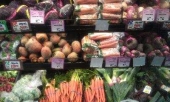




Our inability to change everything should not stop us from changing what we can.









 I still have some tomatoes and potatoes from last year but that is about it as far as home grown garden products.
I still have some tomatoes and potatoes from last year but that is about it as far as home grown garden products. [img]http://i109.photobucket.com/albums/n52/havlik1/permie%20pics2/permiepotrait3pdd.jpg[/img]
"One cannot help an involuntary process. The point is not to disturb it. - Dr. Michel Odent




Brenda
Bloom where you are planted.
http://restfultrailsfoodforestgarden.blogspot.com/




The ultimate goal of farming is not the growing of crops, but the cultivation and perfection of human beings. - Masanobu Fukuoka





Our inability to change everything should not stop us from changing what we can.




 1
1





"the qualities of these bacteria, like the heat of the sun, electricity, or the qualities of metals, are part of the storehouse of knowledge of all men. They are manifestations of the laws of nature, free to all men and reserved exclusively to none." SCOTUS, Funk Bros. Seed Co. v. Kale Inoculant Co.





















Sustainable Plantations and Agroforestry in Costa Rica




Raising meat chickens, egg chickens, and angora rabbits, striving to grow 80% of our own food, spinning our own yarn, wildcrafting, herbal medicining, and enjoying life on Rocky Acres (fondly AKA 'The Beautiful Happy Hippy Organic Peace Family Farm)




Leah Sattler wrote:
goat meat is good but has its limitations.
Gary




TCLynx




There is nothing permanent in a culture dependent on such temporaries as civilization.
www.feralfarmagroforestry.com




There is nothing permanent in a culture dependent on such temporaries as civilization.
www.feralfarmagroforestry.com





Our inability to change everything should not stop us from changing what we can.




There is nothing permanent in a culture dependent on such temporaries as civilization.
www.feralfarmagroforestry.com




There is nothing permanent in a culture dependent on such temporaries as civilization.
www.feralfarmagroforestry.com




There is nothing permanent in a culture dependent on such temporaries as civilization.
www.feralfarmagroforestry.com









Our inability to change everything should not stop us from changing what we can.




There is nothing permanent in a culture dependent on such temporaries as civilization.
www.feralfarmagroforestry.com




There is nothing permanent in a culture dependent on such temporaries as civilization.
www.feralfarmagroforestry.com

 1
1




Our inability to change everything should not stop us from changing what we can.




There is nothing permanent in a culture dependent on such temporaries as civilization.
www.feralfarmagroforestry.com





Our inability to change everything should not stop us from changing what we can.




There is nothing permanent in a culture dependent on such temporaries as civilization.
www.feralfarmagroforestry.com





Our inability to change everything should not stop us from changing what we can.




There is nothing permanent in a culture dependent on such temporaries as civilization.
www.feralfarmagroforestry.com



















Our inability to change everything should not stop us from changing what we can.

















|
Because those who mind don't matter and those who matter don't mind - Seuss. Tiny ad:
The new kickstarter is now live!
https://www.kickstarter.com/projects/paulwheaton/garden-cards
|







